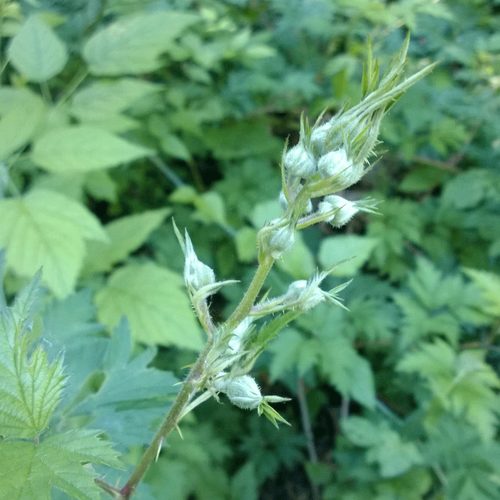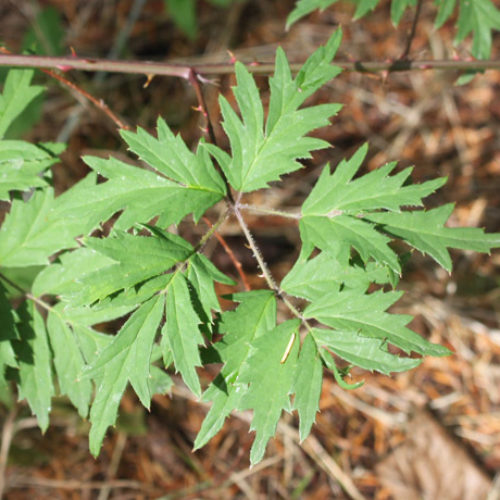Evergreen Blackberry
Rubus laciniatus

Family: Rosaceae
Other Common Names: cutleaf blackberry
Weed class: C
Year Listed: 2009
Native to: Eurasia
Is this Weed Toxic?:
not known to be
Why Is It a Noxious Weed?
It outcompetes native vegetation and prevents the establishment of native trees that require sun for germination. It forms impenetrable thickets that block access to water and lacks the deep, bank stabilizing roots of native wetland shrubs and trees.
How would I identify it?
General Description
It is an upright to rambling evergreen, perennial, woody shrub with stout stems that possess stiff, sharp, recurved prickles. It may grow up to 13 feet and stems can be about 30 feet long. Plants grow into impenetrable thickets.
Flower Description
Flowers are in clusters of 5 to 20. Each flower has 5 petals and 5 sepals. Petals are white to dark pink in color and are 3 lobed at the tips.
Leaf description
Leaves are alternately arranged and generally made up of 5 leaflets that are deeply divided and lobed with toothed margins. Leaves are green to dark green in color. Leaf undersides have hairs.
Stem description
Its upright to arched stems, or canes, are angled, branched and have curved prickles that are reddish at the base and yellow to white toward the tip. Canes are usually biennial and can root along the stems and tips.
Fruit Seed Description
Mature fruit are shiny, black aggregate drupelets (blackberries). They are very tasty and ripen mid to late summer.
Where does it grow?
It grows in a wide range of conditions including disturbed areas, pastures, forest plantations, roadsides, riparian areas, riverbanks and wetland edges. Please click here to see a county level distribution map of evergreen blackberry in Washington.
How Does it Reproduce?
Flowers can be self pollinated or be pollinated. It reproduces by seed and also vegetatively by sprouting root buds and root development on canes.
How Do I Control It?
General Control Strategy
Check with local county noxious weed control boards to comply with requirements in critical areas and buffers, or to control in areas where permits are required. Depending on the size and location of populations, there are a number of management options that can be used to control evergreen blackberry.
Mechanical Control
Hand pulling and grubbing out root balls is effective in controlling small infestations. Make sure to remove all roots as large roots left in the ground can re-sprout. Repeated mowing, several times a year over a number of years, can eventually kill the plant.
Biological Control
Long term grazing of goats can kill blackberry. Goats and pigs can control re-growth from 1 to 4 years old. Goats do tend to avoid mature canes. Chickens may decrease the seed banks.
Herbicide Control
There are several chemical methods for controlling evergreen blackberry. Please refer to the PNW Weed Management Handbook, or contact your county noxious weed coordinator.
For More Information
See our Written Findings for more information about Evergreen Blackberry (Rubus laciniatus).
Cowlitz County NWCB Fact Sheet on invasive blackberries
Jefferson County NWCB Fact Sheet on invasive blackberries
Whatcom County NWCB Fact Sheet on invasive blackberries
Asotin County NWCB Fact Sheet on invasive blackberries
Clark County NWCB Fact Sheet on invasive blackberries
King County NWCB Fact Sheet on invasive blackberries
Control Options for Blackberry from King County NWCB










